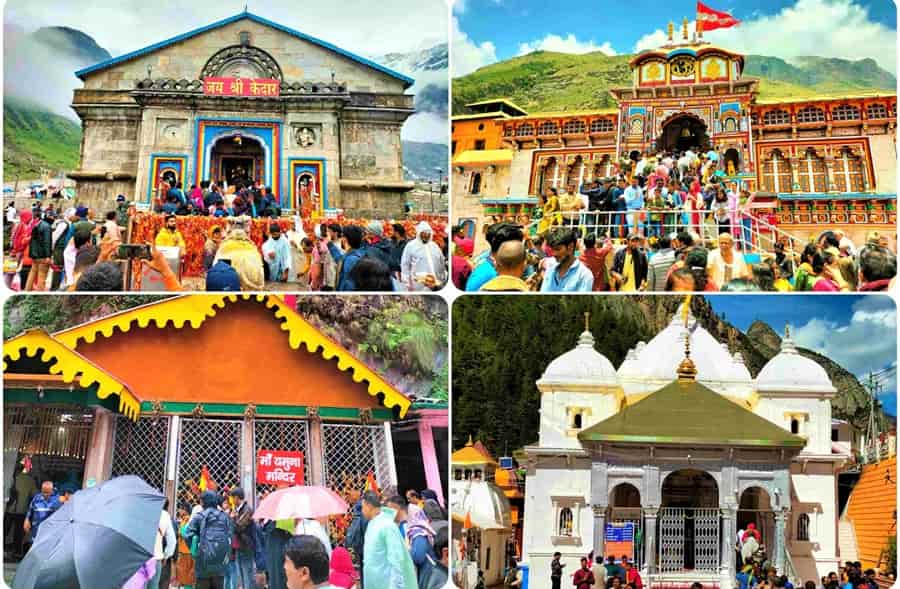Last Updated on 05/06/2025
Char Dham Yatra, holding immense importance and is known as one of the most revered Hindu pilgrimages. It is associated with two major deities, Lord Shiva and Lord Vishnu and two sacred rivers Yamuna and Ganga in Hinduism. Millions of devotees embark on this religious journey every year. They believe that this tour will empty out all the negativity, wash away all their sins, and show the way to attain salvation.
This devotional Yatra does not only reflect its religious relevance but radiates a sense of unity among the Sanatan Dharma followers of different regions. It showcases the true meaning of Unity in Diversity, i.e., the devotees with diverse backgrounds sharing similar spiritual sentiments.
Further in this blog, we will see its importance from different parameters, how the significance of this sacred voyage evolved with time, its relevance in today’s world, and the reason for it bringing profound changes in the lives of pilgrims.

Historical Facts About Each Place
As we know, the circuit of Char Dham involves four religious sites, Yamunotri, Gangotri, Kedarnath, and Badrinath and all of them belong to different Gods.
Let’s know about their history one by one:
Yamunotri:
Yamunotri temple has the idol of Maa Yamuna in the sanctum sanctorum. This revered temple is located in the Uttarkashi district of Uttarakhand. Its history dates back to 1839 when it was first constructed on the orders of Sudarshan ji, the king of Tehri Garhwal.
As the Hindu scriptures suggest, Asti Muni, the sage, came here to meditate in the serene vicinity of Yamunotri Dham. It is also believed that when he became too old to walk, Maa Ganga herself appeared as a river beside the Yamuna.
Gangotri:
The Nepalese Gurkha general, Amar Singh Thapa, is believed to be the constructor of the present Gangotri temple.
The Hindu books and texts have several pieces of evidence that prove the divinity of this place where the celestial river Ganga flowed down into the earth.
Kedarnath:
Apart from its origin, the idol of Kedarnath, which looks just like a bull’s hump, was found and enshrined by the great Hindu philosopher Adi Shankaracharya around the 8th century.
The credit for constructing this temple is also given to him because he rebuilt it where further modifications and renovations were made by Raja Bhoj.
Badrinath:
Similar to Kedarnath, Adi Shankaracharya is believed to be the reason for the revival of the temple around the 7th and 8th centuries. However, the present architecture and outlook of the shrine were given by the Garhwal kings in the later centuries.
Religious Significance of Each Place
Yamunotri:
This ancient temple is the birthplace of the second most pious river, Yamuna. It serves as the starting point of the Char Dham Circuit, glorifying its ultimate religious importance. In the inner sanctum, devotees behold her divine idol of black marble.
Before that, they take a dip into the holy water of Surya Kund to purify their soul and body. The bathing in this religious river Yamuna and her Darshan are considered highly auspicious.
Gangotri:
The Gangotri glacier is supposed to be the place where Goddess Ganga descended to the earth. Its religious significance can be seen in the utter faith and devotion carried by the followers of Hinduism, residing in any part of the world.
The water of the Ganga River is said to possess mystical powers and is the symbol of purification that grants moksha in the afterlife and cleanses your evil deeds of the present life.
Kedarnath:
Among the twelve Jyotirlingas, Kedarnath is the one settled in the northern direction. It’s highly significant among the Hindus, especially Shaivites. The magnificence and greatness of the temple are thoroughly expressed in the religious text called Kritya-kalpataru.
Badrinath:
Badrinath is among the Char Dham of Lord Vishnu located in all the four directions. Moreover, it also holds a place in the 108 Divya Desams. The temple is referred to as an earthly abode of the god, amidst the charming Himalayas of Uttarakhand.
The shrine is highly revered among the followers of Vaishnavism and the sages who come here to meditate.
Cultural and Social Significance
The Char Dham Yatra is deeply rooted in the heart of Hindus. Even for some of them, it’s a spiritual dream to undertake this Yatra at least once in the lifetime. Through the means of this divine tour to Uttarakhand, the pilgrims get to witness the ancient traditions and cultures. These years old rituals have always been there, which were preserved by our great sages, priests, and mindful ancestors.
Additionally, this pilgrimage promotes collective rituals, blending spirituality with Indian culture and community gatherings. This further helps in spreading awareness of a clean environment and lets people praise the natural beauty of the Himalayas.
The improved infrastructure brings in more tourism and makes the Yatra more accessible for the pilgrims, boosting the economy for those living in villages and remote areas.
Relevance of Char Dham Yatra in Modern Days
In today’s world of globalization where people are overly engrossed in their working periods, whether serving others or running a business. The Char Dham Yatra offers the needed spiritual exposure and exploration in the stunning landscapes of the Himalayas.
To be able to cope with the mental stress building continuously over our heads, it becomes necessary to take a break and seek inner peace and a deeper connection with god. The trip to awakened sites like Char Dham temples helps us improve our emotional and mental well-being.
It not only bridges the gap between the generations but also encourages us to preserve our traditions and cultural heritage.
Conclusion
Char Dham Yatra of Uttarakhand is a significant religious practice in the Indian culture. It provides a golden opportunity for you to strengthen the divine connection with the supreme deities. On this journey, you understand the value of faith, devotion, and belief towards the universe and god, that are beyond the material world.
Through this blog, we have tried to convey the core importance of this sacred trip. We hope you will find it interesting and centric.
Suggested Tour


 Call
Call WhatsApp
WhatsApp Enquiry
Enquiry